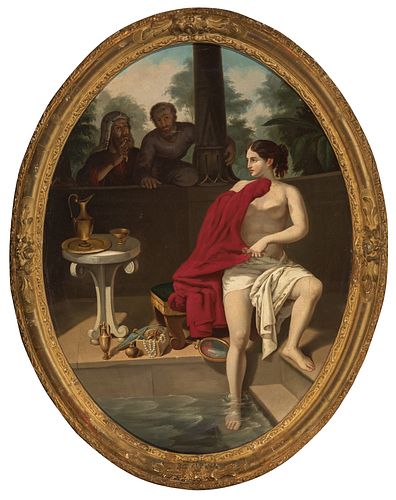Spanish school; ca. 1850. "Susana and the old men". Oil on canvas.
Lot 27
About Seller
Setdart Auction House
Carrer Aragó 346
Barcelona
Spain
Setdart Subastas was born in 2004 and is currently the first online art auction in Spain with solidity, prestige and reliability guaranteed by our more than 60,000 users. Setdart has a young, dynamic and enterprising team ready to successfully manage the purchase and sale of art works through custom...Read more
Estimate:
EUR€1,500 - EUR€2,000
$1,612.90 - $2,150.54
Absentee vs Live bid
Two ways to bid:
- Leave a max absentee bid and the platform will bid on your behalf up to your maximum bid during the live auction.
- Bid live during the auction and your bids will be submitted real-time to the auctioneer.
Bid Increments
| Price | Bid Increment |
|---|---|
| EUR€0 | EUR€10 |
| EUR€200 | EUR€25 |
| EUR€500 | EUR€50 |
| EUR€1,000 | EUR€100 |
| EUR€3,000 | EUR€200 |
| EUR€5,000 | EUR€500 |
| EUR€10,000 | EUR€1,000 |
| EUR€20,000 | EUR€2,000 |
| EUR€50,000 | EUR€5,000 |
About Auction
By Setdart Auction House
Nov 3, 2021
Set Reminder
2021-11-03 08:00:00
2021-11-03 08:00:00
America/New_York
Bidsquare
Bidsquare : OLD MASTERS
https://www.bidsquare.com/auctions/setdart-auction-house/old-masters-7786
Setdart Auction House sofia@setdart.com
Setdart Auction House sofia@setdart.com
- Lot Description
Spanish school; ca. 1850. "Susana and the old men". Oil on canvas. Measurements: 73 x 57 cm; 83 x 65.5 cm (frame). We see in this painting the theme of Susanna in the bath, a story told in the Old Testament, specifically in the Book of Daniel. It belongs to the Greek version of the Bible, known as the Septuagint, whose origin dates back to the third century B.C. Susanna was a beautiful and chaste woman, wife of Joachim, a rich Jew of the Babylonian Exile. She is seen and desired by two elders who had been appointed judges among the Jews in exile; both agree to surprise her alone and convince her to give herself to them. In the most widespread version in the art of the story, this occurs during the young woman's bath. Susanna, however, confronts the elders, and tells them that she prefers death to sin. The men, seeing themselves rejected, accuse Susanna of adultery, and she is brought to trial, where they falsely testify against her. In view of the importance of her accusers, Susanna is condemned to death by stoning. However, on the way to her death the prophet Daniel, who is then only a child, stops the popular procession and rebukes the people for acting without full knowledge of the cause, and asks to separate the two elders for intelligent questioning. The two false witnesses then fall into contradiction in their statements, and are condemned to death instead of Susana. By the type of workmanship and dynamic composition the work is very reminiscent of some of the works of Antonio María Esquivel (Seville, 1806 - Madrid, 1857). Esquivel was the most representative and prolific painter of Sevillian romanticism, and one of the most outstanding of his time in Spain. His life was a true romantic plea; lost his fortune after the death of his father, he was orphaned and poor, with seventeen years he enlisted against the absolutist cause of the Duke of Angoulême, and did not live comfortably until his move to Madrid in 1831.
- Shipping Info
-
In-house shipping available. Please inquire at admin@setdart.com.
-
- Buyer's Premium



 EUR
EUR CAD
CAD AUD
AUD GBP
GBP MXN
MXN HKD
HKD CNY
CNY MYR
MYR SEK
SEK SGD
SGD CHF
CHF THB
THB
















